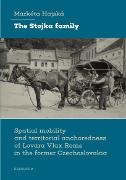The Stojka family Spatial mobility and territorial anchoredness of Lovara Vlax Roms in the former Czechoslovakia

Publication date
2024Publisher / Publication place
Karolinum (Praha)ISBN / ISSN
ISBN: 978-80-246-5917-6Metadata
Show full item recordCollections
Abstract
The Stojka Family features the distinctive testimony of said Romani family, allowing for a representation of "traveling gypsies" and their forced sedentarisation. The book shines a light on the lesser-known Lovara community, accompanied by solid data from extensive archival research, oral history, and other ethnological methods.The book details the story of a Vlax Romani - Lovara family, focusing on its legal, economic, and social attachment to the territory of the former Czechoslovakia from the end of the nineteenth century to the 1960s. The author shows the various forms of spatial mobility and anchoring of those who identified themselves as Lovara, and who were simultaneously labeled by state authorities as "gypsies" or "travelling gypsies." The distinctive testimony focuses on instruments of anti-Roma legislation over a long time, across very diverse political regimes, different regions, and changing socio-economic conditions, and traces in detail the impact of these measures on the lives of the Roms. The book presents perhaps the most detailed treatment of the history and trajectory of a single Romani family on the teritorry of former Czechoslovakia and offers a new perspective on the so-called "Romani itinerancy," providing valuable insights in the fields of social and cultural anthropology, ethnology, sociology, and Romani studies
Keywords
Roms, Lovara, spatial mobility, teritorial anchoring, anti-gypsy mesures, Czechoslovakia, forced sedentarisation, social status, nomadisation
Permanent link
https://hdl.handle.net/20.500.14178/2891License
Full text of this result is licensed under: Creative Commons Uveďte původ-Neužívejte dílo komerčně-Nezpracovávejte 4.0 International




